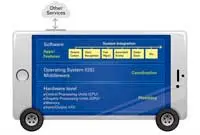Electronics News
Archive : 23 September 2017 год
 Delphi Automotive has signed an agreement to use the BlackBerry operating system in its Centralised Sensing Localisation and Planning (CSLP) concept. The turnkey automated driving solution, planned to launch in 2019, is said to provide car manufacturers with Automated Mobility on Demand functionality.
Delphi Automotive has signed an agreement to use the BlackBerry operating system in its Centralised Sensing Localisation and Planning (CSLP) concept. The turnkey automated driving solution, planned to launch in 2019, is said to provide car manufacturers with Automated Mobility on Demand functionality.
The BlackBerry QNX OS for Safety will be used alongside Delphi’s proprietary Ottomatika software algorithms and middleware to enhance performance and safety. As part of the deal, both companies will work to improve software performance and safety in autonomous driving technology.
“BlackBerry QNX will provide a robust software infrastructure for CSLP and help advance Delphi's autonomous driving system,” claimed Glen De Vos, Delphi’s chief technology officer. “Safety in high performance computing systems is paramount to a production ready autonomous driving solution.”
“There is no safety without security,” said John Wall, general manager of BlackBerry QNX. “With cyberattacks and threats to connected vehicles on the rise, it is imperative that auto manufacturers are provided with software that is safety certified, reliable and secure. This is an area in which BlackBerry QNX excels and we look forward to the new opportunities this expansion with Delphi will bring.”
The BlackBerry OS is said to be certified to ISO 26262 ASIL D for automotive applications.
Author
Graham Pitcher
Source: www.newelectronics.co.uk
 Engineers and scientists from UCLA Henry and non profit R&D organisation SRI International have created a thin flexible device whiuch they believe could keep smartphones and laptop computers from overheating. The team also envisages applications in wearable electronics, robotic systems and new types of personalised cooling systems.
Engineers and scientists from UCLA Henry and non profit R&D organisation SRI International have created a thin flexible device whiuch they believe could keep smartphones and laptop computers from overheating. The team also envisages applications in wearable electronics, robotic systems and new types of personalised cooling systems.
The solid state cooling device approach is based on the electrocaloric effect. It uses a thin polymer film that transfers heat from the source to a heat sink and alternates contact between the two by switching a voltage on and off. Because the polymer film is flexible, the system could be adapted for devices with complex curvature or with moving surfaces.
“We were motivated by the idea of devising a personalised cooling system,” said Professor Qibing Pei. “For example, an active cooling pad could keep a person comfortable in a hot office and thus lower the electricity consumption for building air conditioning. Or it could be placed in a shoe insole or in a hat to keep a runner comfortable in the hot Southern California sun. It’s like a personal air conditioner.”
However, the major application is potentially in mobile and wearable electronics, where thermal management remains a major challenge. The UCLA–SRI system is said to have advantages over thermoelectric coolers.
Prof Pei said other potential applications could include a flexible pad for treating injuries or reducing noise in thermographic cameras and night vision devices.
Author
Graham Pitcher
Source: www.newelectronics.co.uk
 Recognising that security touches all the markets its addresses, Synopsys’ ARC division has launched a preverified hardware and software IP package intended to secure high value embedded applications.
Recognising that security touches all the markets its addresses, Synopsys’ ARC division has launched a preverified hardware and software IP package intended to secure high value embedded applications.
Called the DesignWare ARC secure IP subsystem, the solution features either the SEM110 or 120D security processor, both featuring SecureShield technology. This, says the company, enables the creation of a trusted execution environment.
Rich Collins, product marketing manager, IP subsystems, said: It’s based on the SEM processor, which was launched last year. It has additional security features, including uniform timing to prevent side channel analysis.”
Collins believes security is now important at all levels, as product complexity moves ‘down and to the left’. “This pre verified solution addresses a range of attack agents.”
The subsystem addresses three potential areas of attack: the network; the device itself; and the chips inside. Looking to counter attacks, it includes software and hardware accelerated cryptography options, as well as secure instruction and data memory controller. Collins noted: “It has a secure external memory controller, much like a small cache with built in encryption. It handles instructions and data, reducing latency. Because external memory is insecure, you can keep code in on chip memory and decrypt it on the fly as it’s used.”
However, the level of cryptography in the end chip will be defined by area versus performance trade offs. “The dedicated hardware engine has specialised instruction, but an external interface allows instructions to be added which accelerate software cryptography,” Collins said. “Embedded SIM customers see this a ‘happy medium’, giving them more performance without taking a gate count hit.”
Hardware security features are complemented by software, including a NIST-validated cryptography library, the SecureShield Runtime Library and secure boot support.
Author
Graham Pitcher
Source: www.newelectronics.co.uk

